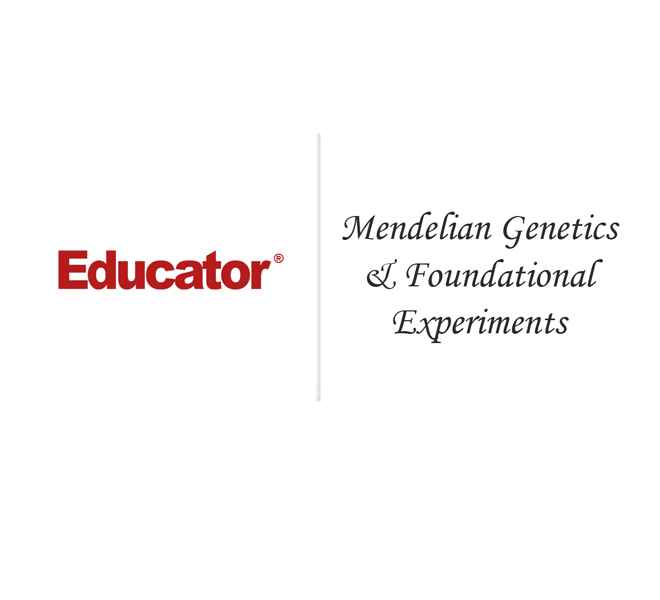For more information, please see full course syllabus of Molecular Biology
For more information, please see full course syllabus of Molecular Biology
Discussion
![]() Answer Engine
Answer EngineStudy Guides
Practice Questions
Download Lecture Slides
Table of Contents
Transcription
Mendelian Genetics & Foundational Experiments
- Gregor Mendel is known as “The Father of Modern Genetics”.
- Punnett squares can be used to track the Mendelian inheritance of genotypes and phenotypes of future generations.
- Rosalind Franklin, and James Watson and Francis Crick are responsible for the discovery of DNA as the genetic material of the cell.
- Genes are found on chromosomes.
- The central dogma of molecular biology is as follows: DNA→RNA→Protein
Long, 4 examples, 5 practice questions
Mendelian Genetics & Foundational Experiments
- James Watson
- Francis Crick
- Gregor Mendel
- Rosalind Franklin
- Frederick Griffith
- Beadle and tatum
- Erwin Chargaff
- Sydney Brenner
- RNA
- DNA
- Protein
- Lipid
- DNA to RNA
- RNA to Protein
- DNA to Protein
- DNA to RNA to Protein
- UUU
- TTT
- CAG
- GGG
*These practice questions are only helpful when you work on them offline on a piece of paper and then use the solution steps function to check your answer.
Answer
Mendelian Genetics & Foundational Experiments
Lecture Slides are screen-captured images of important points in the lecture. Students can download and print out these lecture slide images to do practice problems as well as take notes while watching the lecture.
- Intro
- Lesson Overview
- Gregor Johann Mendel
- Was a Biologist and Botanist
- Published Seminal Paper on Hybridization and Inheritance in the Pea Plant
- Results Criticized
- Father of Modern Genetics
- Mendel’s Laws
- 1st Law: Principle of Independent Segregation of Alleles
- 2nd Law: Principle of Independent Assortment of Genes
- Principle of Independent Segregation (of Alleles)
- True Breeding Lines / Homozygous
- Individuals Phenotypes Determined by Genes
- Alleles
- Alleles Can Be Dominant or Recessive
- Genotypes Can be Experimentally Determined by Mating and Analyzing the Progeny
- Individual Alleles Segregate Independently Into Gametes
- Example 1
- Principle of Independent Segregation (of Alleles)
- Individual Genes Sort Independently Into Gametes
- Each Gamete Receives One Allele of Each Gene: 50/50 Chance
- Genes Act Independently to Determine Unrelated Phenotypes
- Example: Punnett Square
- Example 2
- The Chromosomal Theory of Inheritance
- Walter S Sutton Linked Cytological Studies with Mendels Work
- Diploid Cells Have Two Morphologically Similar Sets of Chromosomes and Each Haploid Gamete Receives One Set
- Genes Are on Chromosome
- Gene for Seed Color’s on a Different Chromosome Than Gene for Seed Texture
- Gene Linkage
- Mendel’s 2nd Law
- Genes Said to Be Linked To Each Other
- Linkage Between Genes
- Linkage is Never 100% Complete
- Genes are Found on Chromosomes
- Thomas Hunt Morgan and Drosophila Melanogaster
- Mutation Linked to X Chromosome
- Linkage of White Gene
- Eye Color of Progeny Depended on Sex of Parent
- Y Chromosome Does Not Carry Copy of White Gene
- X Linked Genes, Allele is Expressed in Males
- Example
- Example 3
- Discovery of the Genetic Material of the Cell
- Transforming Principle
- Experiment with Streptococcus Pneumoniae
- Beadle and Tatum Proposed Genes Direct the Synthesis of Enzymes
- One Gene One Enzyme Hypothesis
- One Gene One Polypeptide Theory
- Showing the Transforming Material was DNA
- Did This by Fractionating Heat-Killed “S” Strains into DNA, RNA, and Protein
- Result: Only the DNA Fraction Could Transform
- Leven: Tetranucleotide Hypothesis
- Chargaff Showed This Was Not the Case
- Chargaff: DNA of Different Species Have Different Nucleotide Composition
- Hershey and Chase: DNA is the Genetic Material
- Incorporate Sulfur into Protein and Phosphorous into DNA
- Results: Phosphorase Entered Bacteria and Progeny Phage, But no Sulfur
- Rosalind Franklin’s “Photo 51” Showing the Diffraction Pattern of DNA
- Watson and Crick: Double Helical Structure of DNA
- Example 4
- Discovery of the Genetic Material of the Cell
- Kornberg: DNA Polymerase I
- Three Postulated Methods of DNA Replication
- Meselson and Stahl: DNA Replication is Semi-Conservative
- How DNA Was Made Denser
- Discovery of RNA
- The Central Dogma of Molecular Biology
- Cracking the Genetic Code
- Intro 0:00
- Lesson Overview 0:22
- Gregor Johann Mendel 1:01
- Was a Biologist and Botanist
- Published Seminal Paper on Hybridization and Inheritance in the Pea Plant
- Results Criticized
- Father of Modern Genetics
- Mendel’s Laws 2:19
- 1st Law: Principle of Independent Segregation of Alleles
- 2nd Law: Principle of Independent Assortment of Genes
- Principle of Independent Segregation (of Alleles) 2:41
- True Breeding Lines / Homozygous
- Individuals Phenotypes Determined by Genes
- Alleles
- Alleles Can Be Dominant or Recessive
- Genotypes Can be Experimentally Determined by Mating and Analyzing the Progeny
- Individual Alleles Segregate Independently Into Gametes
- Example 1 6:18
- Principle of Independent Segregation (of Alleles) 16:11
- Individual Genes Sort Independently Into Gametes
- Each Gamete Receives One Allele of Each Gene: 50/50 Chance
- Genes Act Independently to Determine Unrelated Phenotypes
- Example: Punnett Square
- Example 2 21:36
- The Chromosomal Theory of Inheritance 30:41
- Walter S Sutton Linked Cytological Studies with Mendels Work
- Diploid Cells Have Two Morphologically Similar Sets of Chromosomes and Each Haploid Gamete Receives One Set
- Genes Are on Chromosome
- Gene for Seed Color’s on a Different Chromosome Than Gene for Seed Texture
- Gene Linkage 31:55
- Mendel’s 2nd Law
- Genes Said to Be Linked To Each Other
- Linkage Between Genes
- Linkage is Never 100% Complete
- Genes are Found on Chromosomes 33:00
- Thomas Hunt Morgan and Drosophila Melanogaster
- Mutation Linked to X Chromosome
- Linkage of White Gene
- Eye Color of Progeny Depended on Sex of Parent
- Y Chromosome Does Not Carry Copy of White Gene
- X Linked Genes, Allele is Expressed in Males
- Example
- Example 3 35:52
- Discovery of the Genetic Material of the Cell 41:52
- Transforming Principle
- Experiment with Streptococcus Pneumoniae
- Beadle and Tatum Proposed Genes Direct the Synthesis of Enzymes
- One Gene One Enzyme Hypothesis
- One Gene One Polypeptide Theory
- Showing the Transforming Material was DNA
- Did This by Fractionating Heat-Killed “S” Strains into DNA, RNA, and Protein
- Result: Only the DNA Fraction Could Transform
- Leven: Tetranucleotide Hypothesis
- Chargaff Showed This Was Not the Case
- Chargaff: DNA of Different Species Have Different Nucleotide Composition
- Hershey and Chase: DNA is the Genetic Material
- Incorporate Sulfur into Protein and Phosphorous into DNA
- Results: Phosphorase Entered Bacteria and Progeny Phage, But no Sulfur
- Rosalind Franklin’s “Photo 51” Showing the Diffraction Pattern of DNA
- Watson and Crick: Double Helical Structure of DNA
- Example 4 56:56
- Discovery of the Genetic Material of the Cell 58:09
- Kornberg: DNA Polymerase I
- Three Postulated Methods of DNA Replication
- Meselson and Stahl: DNA Replication is Semi-Conservative
- How DNA Was Made Denser
- Discovery of RNA 1:03:32
- Ribosomal RNA
- Transfer RNA
- Messenger RNA
- The Central Dogma of Molecular Biology 1:04:49
- DNA and Replication
- DNA and Transcription = RNA
- RNA and Translation = Protein
- Reverse Transcription
- Cracking the Genetic Code 1:06:58
- What is the Genetic Code?
- Nirenberg Discovered the First DNA Triplet That Would Make an Amino Acid
- Code Finished in 1966 and There Are 64 Possibilities or Triplet Repeats/ Codons
- Degeneracy of the Code
Molecular Biology Online Course
| Section 1: The Beginnings of Molecular Biology | ||
|---|---|---|
| Biochemistry Review: Importance of Chemical Bonds | 53:29 | |
| Mendelian Genetics & Foundational Experiments | 1:09:27 | |
| Section 2: Structure of Macromolecules | ||
| Structure of Proteins | 49:44 | |
| Structure of Nucleic Acids | 1:02:10 | |
| Section 3: Maintenance of the Genome | ||
| Genome Organization: Chromatin & Nucleosomes | 57:02 | |
| DNA Replication | 1:09:55 | |
| DNA Mutations & Repairs | 1:13:08 | |
| Homologous Recombination & Site-Specific Recombination of DNA | 1:14:27 | |
| Section 4: Gene Expression | ||
| Transcription | 1:19:28 | |
| Translation | 1:15:01 | |
| Section 5: Gene Regulation | ||
| Gene Regulation in Prokaryotes | 45:40 | |
| Gene Regulation in Eukaryotes | 1:06:06 | |
| Section 6: Biotechnology and Applications to Medicine | ||
| Basic Molecular Biology Research Techniques | 1:08:41 | |
| Section 7: Ethics of Modern Science | ||
| Genome Editing, Synthetic Biology, & the Ethics of Modern Science | 45:06 | |
Transcription: Mendelian Genetics & Foundational Experiments
Hello, and welcome back to www.educator.com.0000
Today, we are going to talk about Mendelian genetics and foundational experiments in molecular biology.0003
This is going to be an interesting unit because we are talking mostly about the history of how we started with Gregor Johann Mendel.0009
We are going to go all the way up until we are somewhere in the 20th century, at least.0023
We have to start any talk about molecular biology by starting off with Gregor Mendel.0031
We will then go through chromosomal theory of inheritance.0039
A large chunk of this talk is going to be on the discovery of the genetic material of the cell which we now know is DNA.0043
We will talk briefly on the discovery of RNA and we will mention how the genetic code was cracked.0052
As I said, talking about molecular biology cannot be done without first started talking on Gregor Johann Mendel.0061
Gregor Mendel within the 19th century, at the time he was considered a biologist and a botanist.0071
He did most of his work on plants.0078
He published his similar paper in 1866, hybridization and inheritance of the pea plant.0080
Unfortunately for Mendel, his results were criticized at the time of publication,0090
as only being about hybridization and not being about inheritance.0095
Unfortunately for him, he was not given the respect that he deserved in his time0100
because his results were not widely accepted until after he passed away.0106
That happened in about 1900’s, that is when his work was picked back up by other scientists.0110
However, looking back after the fact now, we consider Gregor Johann Mendel as the father of modern genetics.0116
He did all of this work while being an Augustinian follower, he was a monk.0126
This was his research that he did on the side.0133
Let us talk about Gregor Mendel’s laws.0137
He made two very important laws, based off of his research.0141
This is what he postulated, he showed that there is a principle of independent segregation.0146
We are talking about alleles.0152
His second law is the principle of independent assortment, speaking toward genes.0154
His first law, he started with true breeding lines for certain observable traits, he used his pea plant.0163
What a true breeding line means is that they are homozygous.0172
They always produce the same phenotypes.0177
If it is a green pea, then when you mate two green peas together, you get only green peas.0182
He referred that an individual’s phenotypes was determined by a pair of unit factors.0195
We call those nowadays, we call unit factors, we call these genes.0202
He said different versions of a single gene are called alleles.0214
They can vary just slightly, maybe even as small as a single nucleotide different, in an entire many thousand base pair gene.0219
He said that alleles can be dominate or recessive.0230
What that means is that any recessive gene, for example, if we say that green is dominant but it can also be yellow.0234
Green, if these are the two alleles, anything, if green is dominant, the only thing that two dominant alleles, big g’s, will be green.0250
Anything with even one dominant allele, the big G will be green.0271
Only something with two recessive alleles will be a different phenotype.0281
In this case, let us say it is a red.0292
Your observable phenotype which is this, is what is called a phenotype.0300
Your genetic composition which is this stuff, that would be your genotype.0316
Genotypes can be experimentally determined by mating and then analyzing the progeny.0338
You analyze the phenotypes, the progeny.0347
Remember, phenotype is the innate thing you can see, genotypes is the actual genetic makeup.0349
Individual alleles, he says (Mendel), would segregate independently into gametes or sex cells, like sperm and eggs.0355
With each gamete receiving one allele from each pair, one allele from each pair of alleles.0365
Using a Punnett square, draw out all our possible genotypes and0380
phenotypes of a cross between true breeding white flowers and true breeding purple flowers, with purple being the dominant.0386
Proceed through the F2 generation.0398
First of all, we need to now what all these means.0401
First of all, a Punnett square is a way to visualize those mating.0405
An F2 generation is what is called the filial 2 generation.0412
You start with your parents here, mom and dad.0416
They cross and produce, let us say you and your sister.0427
Right here, let us say you have a baby of your own.0438
When you meet your, for my example, let us say a wife, together you produce a baby.0445
This is what is consider the parental generation.0465
This is the filial, 1st filial generation or F1, this is the F2 generation.0471
Proceed through there using a Punnett square.0478
Remember, our Punnett square would be looking like an actual square, based on all of the genotypes that we get for a specific gene.0480
Let us try this solution.0490
What was dominant, if purple is dominant, let us write that there.0501
Before we start on this, let us go back to Mendel.0511
He mated plants, he mated pea plants.0519
He looked at their seed coat and seed color.0524
If we do an example of Mendel’s seed color or seed coat, then maybe we will be able to understand how to do the flowers.0527
He had true breeding lines, meaning they are homozygous.0538
He took true breeding round seeds and true breeding wrinkled seeds.0541
The round seeds are R, the wrinkled seeds are r and r.0551
This is parental.0559
When you mate them, you get all R and r.0566
Remember, if round at this point is dominant, all of these will be round.0573
Now what you are going to do, you mate the F1 generation to itself.0581
It is going to be another R and r.0589
What you can do, these are going to be all the gametes possible.0594
If these are the female gametes, these are the male gametes, you can make a Punnett square.0609
Our Punnett square is going to look as such.0625
You are going to have your female gametes.0630
All you have to do is fill in the box across from each other.0643
This one, we have a r crossing with a R, this is R and r.0648
These are two R, this right here is a R and r.0657
This right here is two r.0664
In this case, when we end this, by the way, is our F2 generation.0668
In this case, what we have here, remember dominant is round.0675
We have this is round, this is round, this is round, and here is our wrinkled one.0678
As we see here, we have a 3 to 1 ratio of dominant to recessive for phenotype.0687
We have two different phenotypes but we have three different genotypes because we have two of these.0706
Maybe this will help us get our flower one better.0729
Do you want to try?0733
Let us go ahead and give this a try.0735
We have our purple and we have our white.0739
We normally call our genes for the dominant.0742
We will call our purple P and P, we will call our white p and p.0746
This is purple.0759
When they mate, what do we get?0765
We get P and p.0771
That is still going to be what color, purple.0773
This is our F1.0780
What do we have to do, we need to mate this to another P and P.0786
What are our options, we have our p, P, P, p.0793
Let us say this is the mom and this is the dad.0807
If we follow this out, we can make our nice Punnett square with P and P, Pp, our P and P.0816
We have Pp, we have Pp, p and p.0834
What do we have here, we have this being purple, this being purple, this being purple.0842
This one is our lone white.0850
Just the same as this, we have a 3 to 1, in favor of purple for phenotype.0854
We have 3 different genotypes, PP, Pp, pp.0867
Remember we have two of these.0878
Hopefully, we found that helpful.0881
What is very important is that, as I have said before, we always find the phenotype of the heterozygote,0889
or the phenotype of the dominant allele, being seen in the heterozygote, these ones.0896
We are seeing the dominant phenotype in those, in heterozygote.0904
For many alleles, this does not always happen.0913
We do not necessarily have to have alleles that are completely dominant or completely recessive.0919
Then, we got really lucky in the fact his pea plants were true breeding lines in his way and0924
they were either dominant or recessive alleles.0931
Sometimes you can have something called incomplete dominance or co-dominant.0933
That is where, let us say, for example, you had a red flower and a white flower, and you mated those.0937
Let us say if red was dominant, instead of getting 3 red flowers and 1 white flower in the F2 generation,0945
you might get your dominant ones being red, your recessive homozygous ones being white,0954
but your heterozygous ones maybe a shade of pink.0961
That would be what is called incomplete dominance.0965
Mendel’s principle of independent segregation, he is talking about the alleles.0974
Individual genes will sort independently into a gamete.0980
Individual genes, let us say if your gene 1 and gene 2, do not necessarily always have to go into the same sperm or same egg.0985
They can go into different ones.1002
Each gamete receives one allele of each gene with a 50-50 chance.1005
We can use Punnett squares again, to visualize the possible genotypes and phenotypes.1012
What we can see is that, we see that genes will act independently to determine unrelated phenotypes.1018
This is important because we can have multiple genes making a single phenotype, that complicate things even more.1026
Here is an example that of a cat that is being mated with another cat.1037
What we see here is, what is dominant is having a short tail.1044
Short tail is dominant, that is why it is S and brown is dominant.1053
When you are looking at multiple genes, we are looking out here at two genes, it is the coat color and tail length.1060
Each of these genes has a different allele.1081
It can be for coat color, you can be white or brown.1084
For tail length, it can be short or long.1095
Remember this is parental.1103
When you mate true breeding, meaning homozygous parental generation, you are going to get all heterozygote.1107
All your heterozygote, remember are going to have the phenotype of the dominant allele.1119
The dominant allele, the dominant allele for coat color is brown and the dominant allele for tail length is short.1126
What we see here is that all of our F2 generation, all 4 are brown and have short tails.1149
You would mate this F1 generation to each other to produce your F2 genes, right, your F2 offspring.1170
What we see here is that we are no longer looking at our 3 to 1 ratios because now we have two genes involved.1182
We have 16 different possibilities.1189
What do we end up seeing?1192
We see a 9 to 3 to 3 to 1 ratio in the F2 generation.1194
What is it, it is going to be 9 in the double dominant.1203
9 are going to be brown and have short tails.1210
These next 3 are going to be the heterozygous looking ones,1224
to where you are going to be dominant in one thing and recessive in another trait.1228
3 are going to be brown with long tails.1232
We have another separated group, the heterozygous group, because we are independent segregation of these.1241
We are going to have 3 that are white and short.1248
And then, you are going to have one that is recessive for both traits and that is going to be white and long.1255
If we find that one, here is the white and long.1269
This is how we are going to be able to determine any of our true breeding lines, when we are looking at two different genes.1277
We are always going to see this 9 to 3 to 3 to 1 ratio.1285
For an example, let us try this again.1298
Using the Punnett square, draw out all possible genotypes and phenotypes of a cross between white flowers with long stems1300
and red flowers with short stems, with white flowers in short stems both being dominant.1310
Proceed all the way through the F2 generation.1318
White flowers in short stems are dominant.1321
We have a cross between white flowers with long stems and red flowers with short stems.1328
Let us write out what are our parents, what are the parents looks like?1337
We need one that is white, let us give them the W, we need it also to have long stems.1343
Let us give them the s.1353
Now we need one that is red, that is the w.1357
We need one on the short stems, it is a S.1361
This is white and long.1365
This is red and short.1374
If we mate these, what are we going to get?1380
We are going to get the full heterozygote.1385
We are going to get, here are our gametes.1389
I will just write that out so we can see it.1394
Gametes are only W and s, this is only w and S.1397
These crossed are going to give us only this, this is our F1.1404
What is that, what is this going to be, what is dominant?1427
White is dominant, white dominant short.1432
All of these are going to be white with short stems.1434
What are our possible gametes here?1444
It is going to be WS, ws, Ws, and ws.1454
Now, we are going to be able to figure out how to breakdown our Punnett square.1470
Here is going to be our F2.1478
We draw these out, this is going to be the same for both maternal and paternal.1482
Let us draw them out.1487
We have WS right there, WS over there, Ws.1489
Let us go through and figure all these out.1556
This is going to be WW and SS, that is the easy one and this is the easy one too, right.1557
Two w and two s, those are easy ones.1567
We just have to fill them in.1570
This is Ww Ss, this is Ww SS, WW Ss.1572
This is WW Ss, Ww SS, Ww Ss.1578
This is WW ss, this is Ww Ss.1590
This is ww SS, this is Ww Ss, this is Ww ss.1616
Over here, Ww ss, ww Ss.1650
Over here, ww Ss.1662
If we want to look and see, and prove to ourselves that this is in fact in a 9 to 3 to 3 to 1 ratio,1671
let us pick out the simple one first.1684
Here is our single one that has homozygous recessive for both, that is R1.1689
Let us find the 3 that have dominant one and recessive in the other, and the vice versa.1699
Over here, let us see.1711
We have green for this.1715
We will say this is dominant one not in the other.1721
Dominant one not in the other.1727
Dominant one not in the other.1729
This one is red and short.1730
This one was red and short.1741
What about this one?1759
We are looking for the ones that are white.1767
We want to see the ones that are white.1771
Let us see here, we have white and long, and white and long.1775
These are white and long.1788
The other 9 are going to be the ones that are left.1793
Those are going to be the white and short.1803
Can we find those, 1, 2, 3, 4, 5, 6, 7, 8, 9.1812
Each of these 9 have both a dominant allele for white, at least one for white and for short.1822
Let us go on to the next.1839
As I said before, Mendel was not appreciated in his own time.1844
The only reason that he is now appreciate is because other scientists picked up his work1851
and gave him credit for doing the initial work.1857
In 1903, this is about 20 years after Mendel died,1862
the American biologist Walter S. Sutton linked cytological studies with Mendel’s previous work.1866
This researcher Sutton emphasized the importance that diploid cells have two morphologically similar sets of chromosomes.1875
Each haploid gamete, received a single set.1886
He stated that genes are found on chromosomes with one allele on each homologous chromosome.1891
We are going to get more further into this as we move into the course.1898
To explain Mendel’s work, Sutton stated that the gene for seed color1904
was on a different chromosome than the gene for seed texture.1910
Mendel’s second law states that genes should assort independently.1917
But as Sutton was noticing, many genes did not behave that way.1926
These genes were said to be linked to each other.1932
What that means is that these two genes do not sort up independently at a normal 50 to 50 ratio.1936
They are more often seen together than they are separated.1945
Linkage occurs between genes because the genes are located within close proximity to each other1950
and usually on the same chromosome.1958
Linkage is never 100% complete and that is due to the fact that you can have crossing over in meiosis, in late prophase 1.1962
Linkage can be above the normal 50-50 which would be considered an unlinked gene.1973
Seven years later, American biologist Thomas Hunt Morgan and his colleagues1983
found a mutation in the eye color for drosophila melanogaster.1989
This mutation was linked to the X chromosome; flies also have X and Y chromosomes.1994
The linkage of the white gene to the chromosomes is strongly supported2002
Sutton's chromosomal theory of inheritance, proposed just 7 years earlier.2007
Linkage to the sex chromosome was really apparent2016
because the eye color of the progeny depended on the sex of the white eyed parent.2019
The Y chromosome does not carry or copy the white gene at all.2025
No white gene on the Y chromosome.2029
For X linked genes, the allele is expressed phenotypically by males.2036
Regardless of whether it is dominant or recessive because it is the only copy.2041
An example here, we have this being the female, this being the male.2050
The male is white eyed, the female is what we call wild type meaning it is normal, what we see in nature.2062
What we are seeing here is, we have a white wild type female, a white eyed male.2073
We have the F1 generation, this is parental.2082
The F1 generation both females, these are males.2089
Both females and males are wild type, regular brick red eyes is what they call them.2095
In the F2 generation, these guys are going to be mated to each other.2105
In the F2 generation, what we see is we get, this is a male, this is a male, and these are two females.2110
What we end up seeing is, we get 3 that have the brick red wild type eyes and 1 that has white eyes, and it is a male.2120
When the parent is, with the white eyes is a male, in the F2 generation,2137
the one that gets the white eyes is also going to be a male.2147
The mutation for white eyes, we noticed, when wild type is red and2155
we know that the mutation arose spontaneously but very infrequently.2159
What is important is that we know that males which are just like in humans, XY is a male and female is XX.2164
Males always donate their Y to any son and they always donate their X to any daughter.2185
We know that sons always receive their X from their mom, this is important.2205
Using this information, let us find out what the F1 and F2 generations would look like,2217
if the original parents were white eyed female and a wild type male.2224
The opposite of what we saw before.2229
Let us draw out our parental.2234
We have a female that is white eyed, we are going to call the ww.2241
Then we have a male that is a red eyed, W.2250
Instead of putting another W there, the Y chromosome does not have the gene for white on it,2255
we are just going to put Y for Y chromosome.2261
When they mate, they are going to produce the F1 generation which is what, what can we get?2265
We are only going to get, it is different now.2279
We now, the whole X and Y.2286
All of the females will get the X from their father, they get a big Y, this is going to be a red eyed.2291
Let us make this clear, this is red eye and this is white eyed.2307
The female is going to only be able to inherit that, right.2320
They will be able to get one of these from their mom.2332
Any males will be like this.2339
What we see here is that the females in the F1 generation will all be wild type which is red.2358
The males will all be mutant which is white.2369
If we mate these two together, what are our options?2376
What we can see here is that we have two boys, two girls, or two females and two males.2412
What do we see, let us look at this one.2422
What is this one going to be? Ww.2426
First of all, we know it does not have a Y, it is going to be a female.2431
We see that it does not have a W, this is going to be white.2434
Let us look at this one, it is w and Y, we know it is a male.2445
We know it does not have a W, it is also going to be white.2454
When we look at this one, Ww, we know it does not have Y, it is a female.2463
We have a W, it is wild type or red eyed.2472
The last one here, WY, it got a Y so we know it is a male and we have a W, therefore it is also red.2476
That is what we see here, we get two white eyed and two red.2489
But we get both a white female and a white eyed male.2493
We can start moving closer and closer to current time.2507
Now, we are in the 20th century, 15 years or so, after we are able to go through the chromosomal theory of inheritance,2511
we can move on to thinking about how we can discover or how we discovered the genetic material of the cell.2526
To preface this, at the time, scientists believe that the genetic material of the cell were proteins.2534
They did not think that it was DNA, because at the time, the proposed structure of DNA did not lend itself toward replication.2542
They thought that protein was definitely the genetic material of the cell because it had instamatic activity.2556
In 1928, we have British bacteriologist Frederick Griffith,2563
identifying what he termed the transforming principle, the genetic material of the cell.2568
He developed this extremely and genius experiment that took this substance that is in a virulent streptococcus pneumoniae,2575
bacteria, he was able to transform the non-virulent strain of this bacteria into a virulent strain.2585
Virulent means is able to cause a disease.2596
How he did this was, he took the non-virulent strain or the R strain, it was rough looking when it was plated out on Petri dishes.2598
He injected it in a mouse, he took the blood of the mouse and there were no live bacteria.2610
The mouse was perfectly fine and alive.2620
He took this smooth strain, the S strain, because it looks smooth and have this extra protein capsule on it.2623
This was virulent, he injected into the mice, the mouse, all the mice died.2630
He was able to extract from the blood live streptococcus pneumonia.2638
In his next experiment, he heat killed this virulent strain.2645
He killed the bacteria, kind of just like we do with vaccines today.2649
He killed it but still injected into the mouse.2655
The mouse lived and he was not able to pull any live bacteria out of it.2659
This is the most important step right here.2663
He took live R strain which is not virulent and he took heat killed or dead S strain.2670
He mixed those together, injected into the mouse.2684
What did he find?2687
He found that the mouse died and he found that he can recover live S strain.2690
He said, this has got to be the genetic material of the cell, this transforming principle that somehow was able to transform R and S.2699
But what was that, we do not know.2711
Fast forward a little longer, this is on the side before we jump back into the big picture.2717
In 1941, we have Beadle and Tatum proposing that genes throughout the synthesis of enzymes.2724
They did this by irradiating spores on blood mold.2730
They found that these were unable to grow on media without argenine which is amino acid.2734
This amino acid was produced just by a single enzyme.2740
They came up with this hypothesis that one gene makes this one enzyme, one gene one enzyme hypothesis.2744
What I want us to understand is that, this has later been amended to be a one gene one polypeptide theory2753
because we can make more than one enzyme from a single gene.2761
That can be done by alternative splicing that we are going to talk about much later in this course.2765
That was kind of in the side, now we jump back to the main story.2771
In 1944, now we have Maclyn McCarty at the Rockefeller institute, showing what a transforming principle was and they say that it is DNA.2776
How do they do this, they took this heat-killed S strain.2792
They fractionated it into DNA, RNA, and protein.2795
Each fraction was tested for their ability to transform the R strain into the S strain.2811
What they did was they separated each fraction and only gave the DNA from the S strain to the R strain.2819
They would do another sample where there is only the RNA from the S strain to the R.2827
Only the protein from the S to the R, separately.2831
What they found is that the only DNA fraction that could transform an R strain to an S strain was the DNA.2835
The RNA and the protein fraction did not.2844
However, this was still not widely accepted because as I said earlier, at the time,2853
DNA structure that was proposed by Phoebus Leven was not something that can be applied2860
to be able to transfer information, it would be replicated.2869
This is the reason why proteins were thought to be the genetic material.2875
Phoebus Leven, much earlier, in 1910, he proposed what is called the tetranucleotide hypothesis.2880
He predicted that the structure of DNA was planar.2889
An equal quantity of each nucleotides were in each plane.2892
It looked like this down here, we had a guanine and a cytosine, a thymine and adenine, in each plane.2897
They look like squares and they added one on top of each other, so on and so forth.2904
With the phosphate backbone in the middle and the bases on the outside.2909
Luckily, due to this planar prediction, where we had equal, all four in the same plane all the way up,2922
we had another researcher named Chargaff showed that this was not the case.2937
In 1949, we have an Austrian chemist Erwin Chargaff proposing that DNA of different species have different nucleotide composition.2943
It always follows this rule, the amounts of adenines always equal the amount of thymines.2955
The amounts of guanines always equal the amount of the cytosines.2962
The amount of A’s and G’s always equal the amount of C’s the T’s.2967
Importantly, A and T ratio, A + T does not have to equal G + C.2972
They can be varying between different species.2982
This is important and this is something that we know nowadays. We know that A base pairs with T and G base pairs with C.2985
Therefore, this makes a lot of sense.2994
At the time, nobody knew this.2998
Back to discovering the genetic material of the cell, a few years after Chargaff, gave the light toward the end of the tunnel.3002
We have the scientists named Hershey and Chase, this American bacteriologist,3016
a geneticists, conclusively demonstrating that DNA is the genetic material.3021
They did this in a really cool experiment. They took bacteriophage.3029
Bacteriophage is a type of virus that infects bacteria.3035
The bacteriophage is very simple, all it is consisted of is DNA that is inside the head and the rest of it is all protein.3044
The head, the coat, the tail, all these stuff is protein, only what is inside the head is DNA.3060
What Hershey and Chase did is they took radioactive isotopes of sulfur and phosphorus,3070
incorporated them into the growing bacteriophages.3076
You can specifically incorporate sulfur into protein.3081
Meaning, the sulfur was only going to be in the protein coat, on the outside.3091
They also took the phosphorus, this isotope, that could be specifically incorporated into DNA,3100
meaning it is only inside that group on that DNA.3107
What they did was, after growing the bacteriophages in these isotopes, they were allowed to affect the bacteria.3112
As we see here, we have two different types.3123
Ones that were just labeled with the sulfur, only the proteins.3127
Ones that were just labeled with the phosphorus, only the DNA.3140
What they see is, you let them infect.3145
They latch onto the bacteria and shoot their DNA into the bacteria.3147
The whole point they want to do is make new viruses and breakout.3153
They were allowed to infect the bacteria and then, they were thrown literally into this blender3158
It is like a blender you have on your counter.3165
It is actually still held at Cold Spring Harbor, in New York, the original blender that Hershey and Chase performed this experiment with.3168
They threw everything into this blender, heat blend, that basically shakes the bacteria off of everything.3176
It breaks everything open, it shakes the phages to everything.3186
What they found is that the phosphorus, which we know is associated with DNA, was found into the bacteria.3191
As well as the progeny phage but the S35, the sulfur that is in the protein coat, there was not inside the cell.3203
It was only associated with the protein ghosts. That is what they will call the ghosts, it is the empty phage.3214
This is really great, DNA is what is being passed on, not protein, this is huge.3221
In the same year, we have Rosalyn Franklin.3232
Rosalyn Franklin is an English chemist and one of the premier X-ray crystallographers of her time.3237
This in fact is a picture of hers, called photo 51, this shows the diffraction pattern of DNA.3246
If you can actually look at it, we can see that we have a double helical nature.3254
We can even see the minor groove and the major groove, each one in DNA.3259
This is an amazing picture, especially at the time.3267
Unfortunately for Rosalyn Franklin, someone in her laboratory showed this picture, photo 51,3271
to some competing scientist without her authorization.3283
Those competing scientists are very well known now.3290
The names of those competitors are James Watson and Francis Crick.3298
A year later after getting that picture, that photo 51 from Rosalyn Franklin, they deduced the double helical structure of DNA.3303
They published their article in the Nature journal, it was only one page long.3313
It is one of the highest, or if not the highest, cited paper from that journal.3320
What they said in their paper was that two DNA strands are held together by hydrogen bonds and3329
that is between the opposing strands.3338
The bases coming together, make those hydrogen bonds.3342
They said base pair, and they are specific, A pairs with T, G pairs with C only.3346
We have already talked about this, but at the time that was a noble insight.3351
They said that the sequence of one strand defines the sequence of the other strand,3358
meaning that it is complementary.3361
They also noted that it was anti parallel.3366
Remember, 5 prime down to 3 prime for one strand, 5 prime up to 3 prime for the other strand.3368
In that one of the last sentences, they stated that the specific base pairing suggests a possible copying mechanism.3376
This was the whole basis of why DNA could not be the genetic material, as seen before,3387
because it could not be copied.3395
Now, they are saying that the phosphate backbone is on the outside,3398
the bases are on the inside, hydrogen bonded to each other, they are complementary.3401
Therefore, we could probably see a situation where you can copy this pretty easily, although,3405
they did not propose the mechanism.3413
As an example based on Watson and Crick’s solution, fill in this sequence on the bottom strand of DNA following what they said.3417
Remember, A’s pair with T’s, G’s pair with T’s.3431
DNA strands are anti parallel.3435
Remember, we have the 5 prime to 3 prime on the top strand.3438
We have the 5 prime to 3 prime down to the opposite on the bottom strand.3444
If we want to make our bonds, T pairs with A, A pairs with T, C pairs with G, G pairs with C, C pairs with G.3450
Let us not forget, how many bonds?3463
A and T makes two hydrogen bonds, G and C make three hydrogen bonds.3467
This would be our phosphate backbone, right here, of one strand, this is the phosphate backbone of another strand.3477
A few years after Watson and Crick deduced the structure of DNA helix,3491
we had an American biochemist named Arthur Kornberg, he isolated this protein from a bacteria that he called DNA polymerase 1.3497
He showed that DNTP or deoxyribonucleotide triphosphate, they say that DNTP’S meaning it could be an A, G, T, or C.3507
He said that DNTP’s and a DNA molecule will require for DNA synthesis.3520
He showed using templates with different base composition, whether it is high AT or high GC ratio,3531
he showed that the newly synthesized DNA molecules had a similar base composition.3538
Confirming, Watson and Crick’s saying that there was the complimentary between the two strands.3543
Kornberg established that the strand of DNA served as a template for DNA synthesis.3550
But still, he could not way off a mechanism by which it happened.3557
There were three mechanisms that we are offered at the time.3564
Now, we had semi-conservative in which we have here, we started with our parent strand, all red.3569
The two new daughter helices, one of the strand would be completely parental and one of the strand would be completely new.3579
We have conservative, where it is just like a photocopy mechanisms of the two daughters strands.3589
One would be completely old DNA, one would be completely new DNA.3594
We have dispersive, in which case both of the daughter molecules would have new and old.3599
But we would have stretches where both strands were completely old3606
and stretches where both strands are completely new DNA sequence.3611
How do we discover what type of mechanism this is?3616
Two years later, we have Meselson and Stahl showing that DNA replication is semi-conservative,3622
meaning you have the original DNA.3629
When it is newly made, we have one strand being completely old and one strand being completely new.3642
How did they do this, which is a really ingenious experiment?3653
DNA was made denser or heavy, by adding heavy isotope of nitrogen, some nitrogen 15.3658
Then it was subjected to high speed centrifugation through this dense medium of chloride.3666
You either grew DNA in what is called light nitrogen, the normal N14, or the heavy nitrogen the N15.3673
You call that heavy or light DNA.3682
They do grew through 14 generations, so that there was no bias coming in.3686
They are all different.3692
You are either completely in 15 or completely in 14, that was what it was showing.3694
After one round of DNA replication, it opposes the light isotopes.3701
All the daughter molecules have an intermediate density or heavy light, from 100% heavy to 100% intermediate.3710
And then, what they did is they did one more replication.3724
At the point, they saw a reduction of the medium, the intermediate, down to 50%.3729
They saw 50% being fully light.3736
This demonstrates that DNA replication is semi-conservative because you were having the old parental strand being the heavy.3742
You grew it only in heavy to start with, then you started growing it in light.3751
You can only be adding light, you could not add more heavy.3758
By adding, by growing from completely heavy to intermediate, after one replication,3763
it has to be half and half, half old and half new.3771
This does not necessarily mean that, right there that breaks away conservative.3778
We can still have distributive or disperse, as well as semi-conservative.3785
What they did is, they did more and more generations and found that as you increase the generations,3790
you are not adding any more of that old stuff.3797
You are not distributing in between strands; its every new strand is going to be a light strand.3800
That is how they can figure that it was semi-conservative replication, that is a big deal here.3805
That is the end of our DNA, the discovery of the genetic material and how it is replicated.3814
This is a quick overview on the discovery of RNA, we will talk more about RNA later.3821
Ribosomal RNA is one of the three types of RNA.3828
rRNA was discovered in the 50’s by Albert Claude and George Palade.3832
Ribosomal RNA is important for the structure of ribosomes, just a structural purpose.3841
Transfer RNA is what is responsible for bringing in amino acids to the ribosome,3849
to match up with that particular anticodon in the mRNA.3858
MRNA was found in 1956 by Zamecnik and Hoagland.3863
Messenger RNA which is made from DNA and is responsible for dictating the sequence of amino acids3869
for protein synthesis at the ribosome, was discovered in 1960 by Brenner, once again from Francis Crick.3878
Now that we have learn about our DNA and RNA,3886
we should talk quickly about the central dogma in molecular biology, what is that really mean?3889
This is something that we are going to talk about many times throughout this course.3900
The simplest way to explain it is that DNA can make more DNA and that is called the process of replication.3905
DNA can be turned into RNA, this is the metabolic process of transcription.3926
Finally, RNA can be turned into protein via the process of translation.3942
This is what everything that we believe in molecular biology follows.3954
One thing that violates the central dogma is something that you might be familiar with, that is called reverse transcription.3961
This is turning RNA back into DNA, we see this in the type of enzyme, such as retroviruses.3982
They have a sort of enzyme called reverse transcriptase and that is able to turn RNA back into DNA.3991
This is an important thing biologists always have in mind, when we are thinking about the molecular biology central dogma.4001
RNA can be made into protein, how do we figure that out?4009
How do we figure out which RNA will turn into which amino acids?4013
Cracking the genetic code, this is important.4019
If you remember, the genetic code, if we have not learned yet,4022
the genetic code is what tells us what triplet will repeat found in an mRNA will give us a specific amino acid.4026
In 1961, we have an American biochemist and geneticist named Marshall Nirenberg.4036
He discovered the first DNA triplet that would go on to make an amino acid.4041
He did this by taking a bunch of nucleic acid, RNA, but only was made up of U’s.4046
He fed this through the ribosome, in a cell extract, and only phenylalanine amino acids were made.4056
He found out that the first triplet codon ever distinguished was UUU, that coded for phenylalanine.4065
It took about 5 more years and some other researchers helped, but the code was completely finished in 1966.4075
What they found is that they were 64 possibilities of triplet repeats or triplet codons.4082
Each one of these could code for an amino acid.4096
They thought, three of them they found, these are important,4100
were found to not actually add an amino acid and instead cause the release of the polypeptide chain from the ribosome.4106
The other 61, other than these 3, the 61 possible codons all coded for amino acids.4114
What is also very important is that, for example, let us look at this.4127
4 of these different codons will code for serine amino acid.4132
This is what we call the degeneracy of the genetic code, meaning that we can get the same amino acid from multiple different mRNA bases,4139
meaning also since we got the mRNA from the DNA, we can have different genetic sequences giving us the same amino acid sequences.4150
I hope you enjoyed the lesson, thank you very much for coming and please come back to www.educator.com.4161

Michael Philips
Mendelian Genetics & Foundational Experiments
Slide Duration:Table of Contents
53m 29s
- Intro0:00
- Lesson Overview0:14
- Chemical Bonds0:41
- Attractive Forces That Hold Atoms Together0:44
- Types of Bonds0:56
- Covalent Bonds1:34
- Valence Number1:58
- H O N C P S Example2:50
- Polar Bonds7:23
- Non-Polar Bond8:46
- Non-Covalent Bonds9:46
- Ionic Bonds10:25
- Hydrogen Bonds10:52
- Hydrophobic Interactions11:34
- Van Der Waals Forces11:58
- Example 112:51
- Properties of Water18:27
- Polar Molecule13:34
- H-bonding Between Water H20 Molecules19:29
- Hydrophobic Interactions20:30
- Chemical Reactions and Free Energy22:52
- Transition State23:00
- What Affect the Rate23:27
- Forward and Reserve Reactions Occur Simultaneously But at Different Rate23:51
- Equilibrium State24:29
- Equilibrium Constant25:18
- Example 226:16
- Chemical Reactions and Free Energy27:49
- Activation Energy28:00
- Energy Barrier28:22
- Enzymes Accelerate Reactions by Decreasing the Activation Energy29:04
- Enzymes Do Not Affect the Reaction Equilibrium or the Change in Free Energy29:22
- Gibbs Free Energy Change30:50
- Spontaneity31:18
- Gibbs Free Energy Change Determines Final Concentrations of Reactants34:36
- Endodermic vs. Exothermic Graph35:00
- Example 338:46
- Properties of DNA39:37
- Antiparallel Orientation40:29
- Purine Bases Always Pairs Pyrimidine Bases41:15
- Structure Images42:36
- A, B, Z Forms43:33
- Major and Minor Grooves44:09
- Hydrogen Bonding and Hydrophobic Interactions Hold the Two Strands Together44:39
- Denaturation and Renaturation of DNA44:56
- Ways to Denature dsDNA45:28
- Renature When Environment is Brought Back to Normal46:05
- Hyperchromiicity46:36
- Absorbs UV Light47:01
- Spectrophotometer48:01
- Graph Example?49:05
- Example 451:02
1h 9m 27s
- Intro0:00
- Lesson Overview0:22
- Gregor Johann Mendel1:01
- Was a Biologist and Botanist1:14
- Published Seminal Paper on Hybridization and Inheritance in the Pea Plant1:20
- Results Criticized1:28
- Father of Modern Genetics1:59
- Mendel’s Laws2:19
- 1st Law: Principle of Independent Segregation of Alleles2:27
- 2nd Law: Principle of Independent Assortment of Genes2:34
- Principle of Independent Segregation (of Alleles)2:41
- True Breeding Lines / Homozygous2:42
- Individuals Phenotypes Determined by Genes3:15
- Alleles3:37
- Alleles Can Be Dominant or Recessive3:50
- Genotypes Can be Experimentally Determined by Mating and Analyzing the Progeny5:36
- Individual Alleles Segregate Independently Into Gametes5:55
- Example 16:18
- Principle of Independent Segregation (of Alleles)16:11
- Individual Genes Sort Independently Into Gametes16:22
- Each Gamete Receives One Allele of Each Gene: 50/50 Chance16:46
- Genes Act Independently to Determine Unrelated Phenotypes16:57
- Example: Punnett Square17:15
- Example 221:36
- The Chromosomal Theory of Inheritance30:41
- Walter S Sutton Linked Cytological Studies with Mendels Work31:02
- Diploid Cells Have Two Morphologically Similar Sets of Chromosomes and Each Haploid Gamete Receives One Set31:17
- Genes Are on Chromosome31:33
- Gene for Seed Color’s on a Different Chromosome Than Gene for Seed Texture31:44
- Gene Linkage31:55
- Mendel’s 2nd Law31:57
- Genes Said to Be Linked To Each Other32:09
- Linkage Between Genes32:29
- Linkage is Never 100% Complete32:41
- Genes are Found on Chromosomes33:00
- Thomas Hunt Morgan and Drosophila Melanogaster33:01
- Mutation Linked to X Chromosome33:15
- Linkage of White Gene33:23
- Eye Color of Progeny Depended on Sex of Parent33:34
- Y Chromosome Does Not Carry Copy of White Gene33:44
- X Linked Genes, Allele is Expressed in Males33:56
- Example34:11
- Example 335:52
- Discovery of the Genetic Material of the Cell41:52
- Transforming Principle42:44
- Experiment with Streptococcus Pneumoniae42:55
- Beadle and Tatum Proposed Genes Direct the Synthesis of Enzymes45:15
- One Gene One Enzyme Hypothesis45:46
- One Gene One Polypeptide Theory45:52
- Showing the Transforming Material was DNA46:14
- Did This by Fractionating Heat-Killed “S” Strains into DNA, RNA, and Protein46:32
- Result: Only the DNA Fraction Could Transform47:15
- Leven: Tetranucleotide Hypothesis48:00
- Chargaff Showed This Was Not the Case48:48
- Chargaff: DNA of Different Species Have Different Nucleotide Composition49:02
- Hershey and Chase: DNA is the Genetic Material50:02
- Incorporate Sulfur into Protein and Phosphorous into DNA51:12
- Results: Phosphorase Entered Bacteria and Progeny Phage, But no Sulfur53:11
- Rosalind Franklin’s “Photo 51” Showing the Diffraction Pattern of DNA53:50
- Watson and Crick: Double Helical Structure of DNA54:57
- Example 456:56
- Discovery of the Genetic Material of the Cell58:09
- Kornberg: DNA Polymerase I58:10
- Three Postulated Methods of DNA Replication59:22
- Meselson and Stahl: DNA Replication is Semi-Conservative1:00:21
- How DNA Was Made Denser1:00:52
- Discovery of RNA1:03:32
- Ribosomal RNA1:03:48
- Transfer RNA1:04:00
- Messenger RNA1:04:30
- The Central Dogma of Molecular Biology1:04:49
- DNA and Replication1:05:08
- DNA and Transcription = RNA1:05:26
- RNA and Translation = Protein1:05:41
- Reverse Transcription1:06:08
- Cracking the Genetic Code1:06:58
- What is the Genetic Code?1:07:04
- Nirenberg Discovered the First DNA Triplet That Would Make an Amino Acid1:07:16
- Code Finished in 1966 and There Are 64 Possibilities or Triplet Repeats/ Codons1:07:54
- Degeneracy of the Code1:08:53
49m 44s
- Intro0:00
- Lesson Overview0:10
- Amino Acids0:47
- Structure0:55
- Acid Association Constant1:55
- Amino Acids Make Up Proteins2:15
- Table of 21 Amino Acid Found in Proteins3:34
- Ionization5:55
- Cation6:08
- Zwitterion7:51
- Anion9:15
- Example 110:53
- Amino Acids13:11
- L Alpha Amino Acids13:19
- Only L Amino Acids Become Incorporated into Proteins13:28
- Example 213:46
- Amino Acids18:20
- Non-Polar18:41
- Polar18:58
- Hydroxyl19:52
- Sulfhydryl20:21
- Glycoproteins20:41
- Pyrrolidine21:30
- Peptide (Amide) Bonds22:18
- Levels of Organization23:35
- Primary Structure23:54
- Secondary Structure24:22
- Tertiary Structure24:58
- Quaternary Structure25:27
- Primary Structure: Specific Amino Acid Sequence25:54
- Example 327:30
- Levels of Organization29:31
- Secondary Structure: Local 3D29:32
- Example 430:37
- Levels of Organization32:59
- Tertiary Structure: Total 3D Structure of Protein33:00
- Quaternary Structure: More Than One Subunit34:14
- Example 534:52
- Protein Folding37:04
- Post-Translational Modifications38:21
- Can Alter a Protein After It Leaves the Ribosome38:33
- Regulate Activity, Localization and Interaction with Other Molecules38:52
- Common Types of PTM39:08
- Protein Classification40:22
- Ligand Binding, Enzyme, DNA or RNA Binding40:36
- All Other Functions40:53
- Some Functions: Contraction, Transport, Hormones, Storage41:34
- Enzymes as Biological Catalysts41:58
- Most Metabolic Processes Require Catalysts42:00
- Most Biological Catalysts Are Proteins43:13
- Enzymes Have Specificity of Reactants43:33
- Enzymes Have an Optimum pH and Temperature44:31
- Example 645:08
1h 2m 10s
- Intro0:00
- Lesson Overview0:06
- Nucleic Acids0:26
- Biopolymers Essential for All Known Forms of Life That Are Composed of Nucleotides0:27
- Nucleotides Are Composed of These1:17
- Nucleic Acids Are Bound Inside Cells2:10
- Nitrogen Bases2:49
- Purines3:01
- Adenine3:10
- Guanine3:20
- Pyrimidines3:54
- Cytosine4:25
- Thymine4:33
- Uracil4:42
- Pentoses6:23
- Ribose6:45
- 2' Deoxyribose6:59
- Nucleotides8:43
- Nucleoside8:56
- Nucleotide9:16
- Example 110:23
- Polynucleotide Chains12:18
- What RNA and DNA Are Composed of12:37
- Hydrogen Bonding in DNA Structure13:55
- Ribose and 2! Deoxyribose14:14
- DNA Grooves14:28
- Major Groove14:46
- Minor Groove15:00
- Example 215:20
- Properties of DNA24:15
- Antiparallel Orientation24:25
- Phosphodiester Linkage24:50
- Phosphate and Hydroxyl Group25:05
- Purine Bases Always Pairs Pyramidine Bases25:30
- A, B, Z Forms25:55
- Major and Minor Grooves26:24
- Hydrogen Bonding and Hydrophobic Interactions Hold Strands Together26:34
- DNA Topology - Linking Number27:14
- Linking Number27:31
- Twist27:57
- Writhe28:31
- DNA Topology - Supercoiling31:50
- Example 333:16
57m 2s
- Intro0:00
- Lesson Overview0:09
- Quick Glossary0:24
- DNA0:29
- Gene0:34
- Nucleosome0:47
- Chromatin1:07
- Chromosome1:19
- Genome1:30
- Genome Organization1:38
- Physically Cellular Differences3:09
- Eukaryotes3:18
- Prokaryotes, Viruses, Proteins, Small Molecules, Atoms4:06
- Genome Variance4:27
- Humans4:52
- Junk DNA5:10
- Genes Compose Less Than 40% of DNA6:03
- Chart6:26
- Example 18:32
- Chromosome Variance - Size, Number, and Density10:27
- Chromosome10:47
- Graph of Human Chromosomes10:58
- Eukaryotic Cell Cycle12:07
- Requirements for Proper Chromosome Duplication and Segregation13:07
- Centromeres and Telomeres13:28
- Origins of Replication13:38
- Illustration: Chromosome13:44
- Chromosome Condensation15:52
- Naked DNA to Start16:00
- Beads on a String16:13
- Mitosis16:52
- Start with Two Different Chromosomes17:18
- Split Into Two Diploid Cells17:26
- Prophase17:42
- Prometaphase17:52
- Metaphase19:10
- Anaphase19:27
- Telophase20:11
- Cytokinesis20:31
- Cohesin and Condensis21:06
- Illustration: Cohesin and Condensis21:19
- Cohesin21:38
- Condensin21:43
- Illustration of What Happens21:50
- Cohesins27:23
- Loaded During Replication and Cleaved During Mitosis27:30
- Separase27:36
- Nucleosomes27:59
- Histone Core28:50
- Eight Histone Proteins28:57
- Octamer of Core Histones Picture29:14
- Chromosome Condensation via H130:59
- Allows Transition to Compact DNA31:09
- When Not in Mitosis31:37
- Histones Decrease Available Binding Sites32:38
- Histone Tails33:21
- Histone Code35:32
- Epigenetic Code35:56
- Phosphorylation36:45
- Acetylation36:57
- Methylation37:01
- Ubiquitnation37:04
- Example 238:48
- Nucleosome Assembly41:22
- Duplication of DNA Requires Duplication of Histones41:50
- Old Histones Are Recycled42:00
- Parental H3-H4 Tetramers Facilitate the Inheritance of Chromatin States44:04
- Example 346:00
- Chromatin Remodeling48:12
- Example 453:28
1h 9m 55s
- Intro0:00
- Lesson Overview0:06
- Eukaryotic Cell Cycle0:50
- G1 Growth Phase0:57
- S Phase: DNA & Replication1:09
- G2 Growth Phase1:28
- Mitosis1:36
- Normal Human Cell Divides About Every 24 Hours1:40
- Eukaryotic DNA Replication2:04
- Watson and Crick2:05
- Specific Base Pairing2:37
- DNA Looked Like Tetrinucleotide2:55
- What DNA Looks Like Now3:18
- Eukaryotic DNA Replication - Initiation3:44
- Initiation of Replication3:53
- Primer Template Junction4:25
- Origin Recognition Complex7:00
- Complex of Proteins That Recognize the Proper DNA Sequence for Initiation of Replication7:35
- Prokaryotic Replication7:56
- Illustration8:54
- DNA Helicases (MCM 2-7)11:53
- Eukaryotic DNA Replication14:36
- Single-Stranded DNA Binding Proteins14:59
- Supercoils16:30
- Topoisomerases17:35
- Illustration with Helicase19:05
- Synthesis of the RNA Primer by DNA Polymerase Alpha20:21
- Subunit: Primase RNA Polymerase That Synthesizes the RNA Primer De Navo20:38
- Polymerase Alpha-DNA Polymerase21:01
- Illustration of Primase Function Catalyzed by DnaG in Prokaryotes21:22
- Recap24:02
- Eukaryotic DNA Replication - Leading Strand25:02
- Synthesized by DNA Polymerase Epsilon25:08
- Proof Reading25:26
- Processivity Increased by Association with PCNA25:47
- What is Processivity?26:19
- Illustration: Write It Out27:03
- The Lagging Strand/ Discontinuing Strand30:52
- Example 131:57
- Eukaryotic DNA Replication - Lagging Strand32:46
- Discontinuous32:55
- DNA Polymerase Delta33:15
- Okazaki Fragments33:36
- Illustration33:55
- Eukaryotic DNA Replication - Okazaki Fragment Processing38:26
- Illustration38:44
- When Does Okazaki Fragments Happen40:32
- Okazaki Fragments Processing40:41
- Illustration with Okazaki Fragments Process Happening41:13
- Example 247:42
- Example 349:20
- Telomeres56:01
- Region of Repetitive Nucleotide Sequences56:26
- Telomeres Act as Chromosome Caps by Binding Proteins57:42
- Telomeres and the End Replication Problem59:56
- Need to Use a Primer59:57
1h 13m 8s
- Intro0:00
- Lesson Overview0:06
- Damage vs. Mutation0:40
- DNA Damage-Alteration of the Chemical Structure of DNA0:45
- DNA Mutation-Permanent Change of the Nucleotide Sequence1:01
- Insertions or Deletions (INDELS)1:22
- Classes of DNA Mutations1:50
- Spontaneous Mutations2:00
- Induced Mutations2:33
- Spontaneous Mutations3:21
- Tautomerism3:28
- Depurination4:09
- Deamination4:30
- Slippage5:44
- Induced Mutations - Causes6:17
- Chemicals6:24
- Radiation7:46
- Example 18:30
- DNA Mutations - Tobacco Smoke9:59
- Covalent Adduct Between DNA and Benzopyrene10:02
- Benzopyrene10:20
- DNA Mutations - UV Damage12:16
- Oxidative Damage from UVA12:30
- Thymidine Dimer12:34
- Example 213:33
- DNA Mutations - Diseases17:25
- DNA Repair18:28
- Mismatch Repair19:15
- How to Recognize Which is the Error: Recognize Parental Strand22:23
- Example 326:54
- DNA Repair32:45
- Damage Reversal32:46
- Base-Excision Repair (BER)34:31
- Example 436:09
- DNA Repair45:43
- Nucleotide Excision Repair (NER)45:48
- Nucleotide Excision Repair (NER) - E.coli47:51
- Nucleotide Excision Repair (NER) - Eukaryotes50:29
- Global Genome NER50:47
- Transcription Coupled NER51:01
- Comparing MMR and NER51:58
- Translesion Synthesis (TLS)54:40
- Not Really a DNA Repair Process, More of a Damage Tolerance Mechanism54:50
- Allows Replication Past DNA Lesions by Polymerase Switching55:20
- Uses Low Fidelity Polymerases56:27
- Steps of TLS57:47
- DNA Repair1:00:37
- Recombinational Repair1:00:54
- Caused By Ionizing Radiation1:00:59
- Repaired By Three Mechanisms1:01:16
- Form Rarely But Catastrophic If Not Repaired1:01:42
- Non-homologous End Joining Does Not Require Homology To Repair the DSB1:03:42
- Alternative End Joining1:05:07
- Homologous Recombination1:07:41
- Example 51:09:37
1h 14m 27s
- Intro0:00
- Lesson Overview0:16
- Homologous Recombination0:49
- Genetic Recombination in Which Nucleotide Sequences Are Exchanged Between Two Similar or Identical Molecules of DNA0:57
- Produces New Combinations of DNA Sequences During Meiosis1:13
- Used in Horizontal Gene Transfer1:19
- Non-Crossover Products1:48
- Repairs Double Strand Breaks During S/Gs2:08
- MRN Complex Binds to DNA3:17
- Prime Resection3:30
- Other Proteins Bind3:40
- Homology Searching and subsequent Strand Invasion by the Filament into DNA Duplex3:59
- Holliday Junction4:47
- DSBR and SDSA5:44
- Double-Strand Break Repair Pathway- Double Holliday Junction Model6:02
- DSBR Pathway is Unique6:11
- Converted Into Recombination Products by Endonucleases6:24
- Crossover6:39
- Example 17:01
- Example 28:48
- Double-Strand Break Repair Pathway- Synthesis Dependent Strand Annealing32:02
- Homologous Recombination via the SDSA Pathway32:20
- Results in Non-Crossover Products32:26
- Holliday Junction is Resolved via Branch Migration32:43
- Example 334:01
- Homologous Recombination - Single Strand Annealing42:36
- SSA Pathway of HR Repairs Double-Strand Breaks Between Two Repeat Sequences42:37
- Does Not Require a Separate Similar or Identical Molecule of DNA43:04
- Only Requires a Single DNA Duplex43:25
- Considered Mutagenic Since It Results in Large Deletions of DNA43:42
- Coated with RPA Protein43:58
- Rad52 Binds Each of the Repeated Sequences44:28
- Leftover Non-Homologous Flaps Are Cut Away44:37
- New DNA Synthesis Fills in Any Gaps44:46
- DNA Between the Repeats is Always Lost44:55
- Example 445:07
- Homologous Recombination - Break Induced Replication51:25
- BIR Pathway Repairs DSBs Encountered at Replication Forks51:34
- Exact Mechanisms of the BIR Pathway Remain Unclear51:49
- The BIR Pathway Can Also Help to Maintain the Length of Telomeres52:09
- Meiotic Recombination52:24
- Homologous Recombination is Required for Proper Chromosome Alignment and Segregation52:25
- Double HJs are Always Resolved as Crossovers52:42
- Illustration52:51
- Spo11 Makes a Targeted DSB at Recombination Hotspots56:30
- Resection by MRN Complex57:01
- Rad51 and Dmc1 Coat ssDNA and Promote Strand Invasion and Holliday Junction Formation57:04
- Holliday Junction Migration Can Result in Heteroduplex DNA Containing One or More Mismatches57:22
- Gene Conversion May Result in Non-Mendelian Segregation57:36
- Double-Strand Break Repair in Prokaryotes - RecBCD Pathway58:04
- RecBCD Binds to and Unwinds a Double Stranded DNA58:32
- Two Tail Results Anneal to Produce a Second ssDNA Loop58:55
- Chi Hotspot Sequence59:40
- Unwind Further to Produce Long 3 Prime with Chi Sequence59:54
- RecBCD Disassemble1:00:23
- RecA Promotes Strand Invasion - Homologous Duplex1:00:36
- Holliday Junction1:00:50
- Comparison of Prokaryotic and Eukaryotic Recombination1:01:49
- Site-Specific Recombination1:02:41
- Conservative Site-Specific Recombination1:03:10
- Transposition1:03:46
- Transposons1:04:12
- Transposases Cleave Both Ends of the Transposon in Original Site and Catalyze Integration Into a Random Target Site1:04:21
- Cut and Paste1:04:37
- Copy and Paste1:05:36
- More Than 40% of Entire Human Genome is Composed of Repeated Sequences1:06:15
- Example 51:07:14
1h 19m 28s
- Intro0:00
- Lesson Overview0:07
- Eukaryotic Transcription0:27
- Process of Making RNA from DNA0:33
- First Step of Gene Expression0:50
- Three Step Process1:06
- Illustration of Transcription Bubble1:17
- Transcription Starting Site is +15:15
- Transcription Unit Extends From the Promoter to the Termination Region5:40
- Example 16:03
- Eukaryotic Transcription: Initiation14:27
- RNA Polymerase II Binds to TATA Box to Initiate RNA Synthesis14:34
- TATA Binding Protein Binds the TATA Box14:50
- TBP Associated Factors Bind15:01
- General Transcription Factors15:22
- Initiation Complex15:30
- Example 215:44
- Eukaryotic Transcription17:59
- Elongation18:07
- FACT (Protein Dimer)18:24
- Eukaryotic Transcription: Termination19:36
- Polyadenylation is Linked to Termination19:42
- Poly-A Signals Near the End of the pre-mRNA Recruit to Bind and Cleave mRNA20:00
- Mature mRNA20:27
- Dissociate from Template DNA Strand21:13
- Example 321:53
- Eukaryotic Transcription25:49
- RNA Polymerase I Transcribes a Single Gene That Encodes a Long rRNA Precursor26:14
- RNA Polymerase III Synthesizes tRNA, 5S rRNA, and Other Small ncRNA29:11
- Prokaryotic Transcription32:04
- Only One Multi-Subunit RNA Polymerase32:38
- Transcription and Translation Occurs Simultaneously33:41
- Prokaryotic Transcription - Initiation38:18
- Initial Binding Site38:33
- Pribnox Box38:42
- Prokaryotic Transcription - Elongation39:15
- Unwind Helix and Expand Replication Bubble39:19
- Synthesizes DNA39:35
- Sigma 70 Subunit is Released39:50
- Elongation Continues Until a Termination Sequence is Reached40:08
- Termination - Prokaryotes40:17
- Example 440:30
- Example 543:58
- Post-Transcriptional Modifications47:15
- Can Post Transcribe your rRNA, tRNA, mRNA47:28
- One Thing In Common47:38
- RNA Processing47:51
- Ribosomal RNA47:52
- Transfer RNA49:08
- Messenger RNA50:41
- RNA Processing - Capping52:09
- When Does Capping Occur52:20
- First RNA Processing Event52:30
- RNA Processing - Splicing53:00
- Process of Removing Introns and Rejoining Exons53:01
- Form Small Nuclear Ribonucleoproteins53:46
- Example 657:48
- Alternative Splicing1:00:06
- Regulatory Gene Expression Process1:00:27
- Example1:00:42
- Example 71:02:53
- Example 81:09:36
- RNA Editing1:11:06
- Guide RNAs1:11:25
- Deamination1:11:52
- Example 91:13:50
1h 15m 1s
- Intro0:00
- Lesson Overview0:06
- Linking Transcription to Translation0:39
- Making RNA from DNA0:40
- Occurs in Nucleus0:59
- Process of Synthesizing a Polypeptide from an mRNA Transcript1:09
- Codon1:43
- Overview of Translation4:54
- Ribosome Binding to an mRNA Searching for a START Codon5:02
- Charged tRNAs will Base Pair to mRNA via the Anticodon and Codon5:37
- Amino Acids Transferred and Linked to Peptide Bond6:08
- Spent tRNAs are Released6:31
- Process Continues Until a STOP Codon is Reached6:55
- Ribosome and Ribosomal Subunits7:55
- What Are Ribosomes?8:03
- Prokaryotes8:42
- Eukaryotes10:06
- Aminoacyl Site, Peptidyl tRNA Site, Empty Site10:51
- Major Steps of Translation11:35
- Charing of tRNA11:37
- Initiation12:48
- Elongation13:09
- Termination13:47
- “Charging” of tRNA14:35
- Aminoacyl-tRNA Synthetase14:36
- Class I16:40
- Class II16:52
- Important About This Reaction: It Is Highly Specific17:10
- ATP Energy is Required18:42
- Translation Initiation - Prokaryotes18:56
- Initiation Factor 3 Binds at the E-Site19:09
- Initiation Factor 1 Binds at the A-Site20:15
- Initiation Factor 2 and GTP Binds IF120:50
- 30S Subunit Associates with mRNA21:05
- N-Formyl-met-tRNA22:34
- Complete 30S Initiation Complex23:49
- IF3 Released and 50S Subunit Binds24:07
- IF1 and IF2 Released Yielding a Complete 70S Initiation Complex24:24
- Deformylase Removes Formyl Group24:45
- Example 125:11
- Translation Initiation - Eukaryotes29:35
- Small Subunit is Already Associated with the Initiation tRNA29:47
- Formation of 43S Pre-Initiation Complex30:02
- Circularization of mRNA by eIF431:05
- 48S Pre-Initiation Complex35:47
- Example 238:57
- Translation - Elongation44:00
- Charging, Initiation, Elongation, Termination All Happens Once44:14
- Incoming Charged tRNA Binds the Complementary Codon44:31
- Peptide Bond Formation45:06
- Translocation Occurs46:05
- tRNA Released46:51
- Example 347:11
- Translation - Termination55:26
- Release Factors Terminate Translation When Ribosomes Come to a Stop Codon55:38
- Release Factors Are Proteins, Not tRNAs, and Do Not Carry an Amino Acid55:50
- Class I Release Factors55:16
- Class II Release Factors57:03
- Example 457:40
- Review of Translation1:01:15
- Consequences of Altering the Genetic Code1:02:40
- Silent Mutations1:03:37
- Missense Mutations1:04:24
- Nonsense Mutations1:05:28
- Genetic Code1:06:40
- Consequences of Altering the Genetic Code1:07:43
- Frameshift Mutations1:07:55
- Sequence Example1:08:07
45m 40s
- Intro0:00
- Lesson Overview0:08
- Gene Regulation0:50
- Transcriptional Regulation1:01
- Regulatory Proteins Control Gene Expression1:18
- Bacterial Operons-Lac1:58
- Operon2:02
- Lactose Operon in E. Coli2:31
- Example 13:33
- Lac Operon Genes7:19
- LacZ7:25
- LacY7:40
- LacA7:55
- LacI8:10
- Example 28:58
- Bacterial Operons-Trp17:47
- Purpose is to Produce Trptophan17:58
- Regulated at Initiation Step of Transcription18:04
- Five Genes18:07
- Derepressible18:11
- Example 318:32
- Bacteriophage Lambda28:11
- Virus That Infects E. Coli28:24
- Temperate Lifecycle28:33
- Example 430:34
- Regulation of Translation39:42
- Binding of RNA by Proteins Near the Ribosome- Binding Site of the RNA39:53
- Intramolecular Base Pairing of mRNA to Hide Ribosome Binding Site40:14
- Post-transcriptional Regulation of rRNA40:35
- Example 540:08
1h 6m 6s
- Intro0:00
- Lesson Overview0:06
- Eukaryotic Transcriptional Regulations0:18
- Transcription Factors0:25
- Insulator Protein0:55
- Example 11:44
- Locus Control Regions4:00
- Illustration4:06
- Long Range Regulatory Elements That Enhance Expressions of Linked Genes5:40
- Allows Order Transcription of Downstream Genes6:07
- (Ligand) Signal Transduction8:12
- Occurs When an Extracellular Signaling Molecule Activates a Specific Receptor Located on the Cell8:19
- Examples9:10
- N F Kappa B10:01
- Dimeric Protein That Controls Transcription10:02
- Ligands10:29
- Example 211:04
- JAK/ STAT Pathway13:19
- Turned on by a Cytokine13:23
- What is JAK13:34
- What is STAT13:58
- Illustration14:38
- Example 317:00
- Seven-Spanner Receptors20:49
- Illustration: What Is It21:01
- Ligand Binding That Is Activating a Process21:46
- How This Happens22:17
- Example 424:23
- Nuclear Receptor Proteins (NRPs)28:45
- Sense Steroid and Thyroid Hormones28:56
- Steroid Hormones Bind Cytoplasmic NRP Homodimer29:10
- Hormone Binds NRP Heterodimers Already Present in the Nucleus30:11
- Unbound Heterodimeric NRPs Can Cause Deacetylation of Lysines of Histone Tails30:54
- RNA Interference32:01
- RNA Induced Silencing Complex (RISC)32:39
- RNAi33:54
- RISC Pathway34:34
- Activated RISC Complex34:41
- Process34:55
- Example39:27
- Translational Regulation41:17
- Global Regulation41:37
- Competitive Binding of 5 Prime CAP of mRNA42:34
- Translation-Dependent Regulation44:56
- Nonsense Mediated mRNA Decay45:23
- Nonstop Mediated mRNA Decay46:17
- Epigenetics48:53
- Inherited Patterns of Gene Expression Resulting from Chromatin Alteration49:15
- Three Ways to Happen50:17
- DNA Sequence Does Not Act Alone in Passing Genetic Information to Future Generations50:30
- DNA Methylation50:57
- Occurs at CpG Sites Via DNA Methyltransferase Enzymes50:58
- CpG Islands Are Regions with a High Frequency of CpG Sites52:49
- Methylation of Multiple CpG Sites Silence Nearby Gene Transcription53:32
- DNA Methylation53:46
- Pattern Can Be Passed to Daughter Cells53:47
- Prevents SP1 Transcription Factors From Binding to CpG Island54:02
- MECP254:10
- Example 555:27
- Nucleosomes56:48
- Histone Core57:00
- Histone Protein57:03
- Chromosome Condensation Via J157:32
- Linker Histone H157:33
- Compact DNA57:37
- Histone Code57:54
- Post-translational Modifications of N-Terminal Histone Tails is Part of the Epigenetic Code57:55
- Phosphorylation, Acetylation, Methylation, Ubiquitination58:09
- Example 658:52
- Nucleosome Assembly59:13
- Duplication of DNA Requires Duplication of Histones by New Protein Synthesis59:14
- Old Histones are Recycled59:24
- Parental H3-H4 Tetramers58:57
- Example 71:00:05
- Chromatin Remodeling1:01:48
- Example 81:02:36
- Transcriptionally Repressed State1:02:45
- Acetylation of Histones1:02:54
- Polycomb Repressors1:03:19
- PRC2 Protein Complex1:03:38
- PRC1 Protein Complex1:04:02
- MLL Protein Complex1:04:09
1h 8m 41s
- Intro0:00
- Lesson Overview0:10
- Gel Electraophoresis0:31
- What is Gel Electraophoresis0:33
- Nucleic Acids0:50
- Gel Matrix1:41
- Topology2:18
- Example 12:50
- Restriction Endonucleases8:07
- Produced by Bacteria8:08
- Sequence Specific DNA Binding Proteins8:36
- Blunt or Overhanging Sticky Ends9:04
- Length Determines Approximate Cleavage Frequency10:30
- Cloning11:18
- What is Cloning11:29
- How It Works12:12
- Ampicillin Example12:55
- Example 213:19
- Creating a Genomic DNA Library19:33
- Library Prep19:35
- DNA is Cut to Appropriate Sizes and Ligated Into Vector20:04
- Cloning20:11
- Transform Bacteria20:19
- Total Collection Represents the Whole Genome20:29
- Polymerase Chain Reaction20:54
- Molecular Biology Technique to Amplify a Small Number of DNA Molecules to Millions of Copies21:04
- Automated Process Now21:22
- Taq Polymerase and Thermocycler21:38
- Molecular Requirements22:32
- Steps of PCR23:40
- Example 324:42
- Example 434:45
- Southern Blot35:25
- Detect DNA35:44
- How It Works35:50
- Western Blot37:13
- Detects Proteins of Interest37:14
- How It Works37:20
- Northern Blot39:08
- Detects an RNA Sequence of Interest39:09
- How It Works39:21
- Illustration Sample40:12
- Complementary DNA (cDNA) Synthesis41:18
- Complementary Synthesis41:19
- Isolate mRNA from Total RNA41:59
- Quantitative PCR (qPCR)44:14
- Technique for Quantifying the Amount of cDNA and mRNA Transcriptions44:29
- Measure of Gene Expression44:56
- Illustration of Read Out of qPCR Machine45:23
- Analysis of the Transcriptome-Micrarrays46:15
- Collection of All Transcripts in the Cell46:16
- Microarrays46:35
- Each Spot Represents a Gene47:20
- RNA Sequencing49:25
- DNA Sequencing50:08
- Sanger Sequencing50:21
- Dideoxynucleotides50:31
- Primer Annealed to a DNA Region of Interest51:50
- Additional Presence of a Small Proportion of a ddNTPs52:18
- Example52:49
- DNA Sequencing Gel53:13
- Four Different Reactions are Performed53:26
- Each Reaction is Run in a Lane of a Denaturing Polyacrylamide Gel53:34
- Example 553:54
- High Throughput DNA Sequencing57:51
- Dideoxy Sequencing Reactions Are Carried Out in Large Batches57:52
- Sequencing Reactions are Carried Out All Together in a Single Reaction58:26
- Molecules Separated Based on Size59:19
- DNA Molecules Cross a Laser Light59:30
- Assembling the Sequences1:00:38
- Genomes is Sequenced with 5-10x Coverage1:00:39
- Compare Genomes1:01:47
- Entered Into Database and the Rest is Computational1:02:02
- Overlapping Sequences are Ordered Into Contiguous Sequences1:02:17
- Example 61:03:25
- Example 71:05:27
45m 6s
- Intro0:00
- Lesson Overview0:47
- Genome Editing1:37
- What is Genome Editing1:43
- How It Works2:03
- Four Families of Engineered Nucleases in Use2:25
- Example 13:03
- Gene Therapy9:37
- Delivery of Nucleic Acids Into a Patient’s Cells a Treatment for Disease9:38
- Timeline of Events10:30
- Example 211:03
- Gene Therapy12:37
- Ethical Questions12:38
- Genetic Engineering12:42
- Gene Doping13:10
- Synthetic Biology13:44
- Design and Manufacture of Biological Components That Do Not Exist in Nature13:53
- First Synthetic Cell Example14:12
- Ethical Questions16:16
- Stem Cell Biology18:01
- Use Stem Cells to Treat or Prevent Diseases18:12
- Treatment Uses19:56
- Ethical Questions20:33
- Selected Topic of Ethical Debate21:30
- Research Ethics28:02
- Application of Fundamental Ethical Principles28:07
- Examples28:20
- Declaration of Helsinki28:33
- Basic Principles of the Declaration of Helsinki28:57
- Utmost Importance: Respect for the Patient29:04
- Researcher’s Duty is Solely to the Patient or Volunteer29:32
- Incompetent Research Participant30:09
- Right Vs Wrong30:29
- Ethics32:40
- Dolly the Sheep32:46
- Ethical Questions33:59
- Rational Reasoning and Justification35:08
- Example 335:17
- Example 438:00
- Questions to Ponder39:35
- How to Answer40:52
- Do Your Own Research41:00
- Difficult for People Outside the Scientific Community41:42
- Many People Disagree Because They Do Not Understand42:32
- Media Cannot Be Expected to Understand Published Scientific Data on Their Own42:43










































 Answer Engine
Answer Engine
1 answer
Mon Jun 15, 2020 12:33 PM
Post by Sam Smith on May 3, 2020
The lecture was really great enjoyed it. But only thing that confused me was the discovery of the semi conservative form of the dna using the N14 and the N15.
So can yoy explain me that in short.